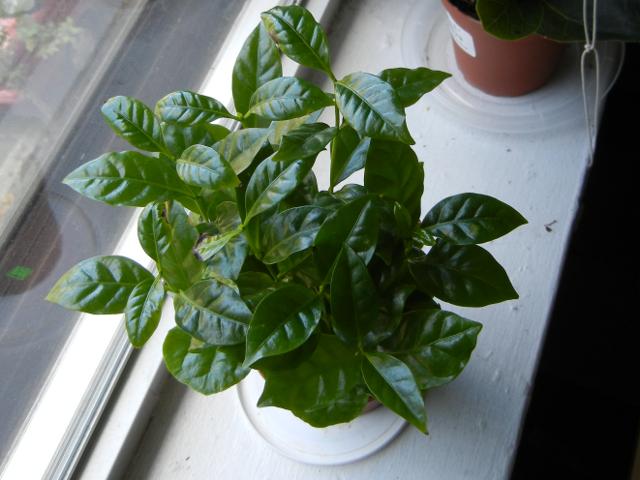Coffee Plant Houseplant in album houseplants
In Albums: plants houseplants

Jul 26th, 2011, by Alex Zorach
This photo shows a coffee plant, Coffea arabica, grown as a houseplant, sitting on my windowsill. I named this plant Al Jazeera after the news source Al Jazeera. I purchased this plant at the Fresh Grocer at 40th and Walnut in West Philadelphia. This is the third coffee plant I have purchased over the years. I grew one in college, which did well for a while but died because of inadequate water when I left at one point. I also grew coffee again when I lived in Cleveland, and this time the plants survived for some time, and I eventually gave them away when I moved.
This plant is actually not a single plant but is a collection of many different plants (in this case, 13 distinct ones) which have sprouted in the same pot from different seeds. When you buy a "coffee plant" at a store, if it has multiple stems, it has probably been sprouted in this manner. In many cases (including on this plant, you can see the cotyledons at the base of the stem. Cotyledons are the first leaves which sprout in a plant; they are contained within the embryo of the seed. In this photo, several cotyledons are visible--they are the more rounded leaves towards the base of the plant. The leaves that have grown later have sharper points.
Growing coffee as a houseplant:
The coffee plant can be grown well as a houseplant, but it is not as easy to care for as most other houseplants. Many of the popular houseplants, like pothos, or a rubber tree, have thick, waxy leaves which can conserve water if the plant goes without water for some time. The coffee plant has thinner, more delicate leaves, and will dry out more rapidly if it goes without water. I have found that this is the largest risk or problem when growing it. This is a biggest problem in the winter when the indoor air is dry.
The coffee plant's light requirements are complex. The coffee plant can be grown in full sun in tropical climates, so if it has adequate moisture, this plant can take as much sun as you give it. However, I have found it to be more tolerant of low lighting than one might expect. The plant pictured here is growing in a window where I pull it out of direct sunlight. I think the biggest problem with respect to lighting levels when growing coffee is that the plant does not do well with abrupt changes in lighting levels. If you move the plant into an area where it gets a lot of direct sun, after having little or none, it will dry up and the leaves will burn easily. If, on the other hand, you move it into an area of lower light, many leaves, especially the lower leaves, will yellow and fall off, as they will not have enough light. I had this problem when growing the plant in Cleveland in winter, where cloudy conditions, short days, and the low angle of the sun produced very low light conditions.
I have seen thriving coffee plants being grown indoors in northern climates with relatively low light levels, without direct sun, and I have seen some of these plants which have grown to 6 feet tall and produced fruit. I suspect that if you provide this plant with adequate moisture and if you keep the lighting conditions relatively constant, you will find it can actually tolerate relatively low light conditions. I have seen some websites recommend it as ideal for an east- or west-facing window, whereas other websites recommend placing it outside in the summer and then taking it indoors. From my experience, I'd recommend against moving it in and out, as I find that it is more stressed by changes in lighting than it is by high or low light alone.